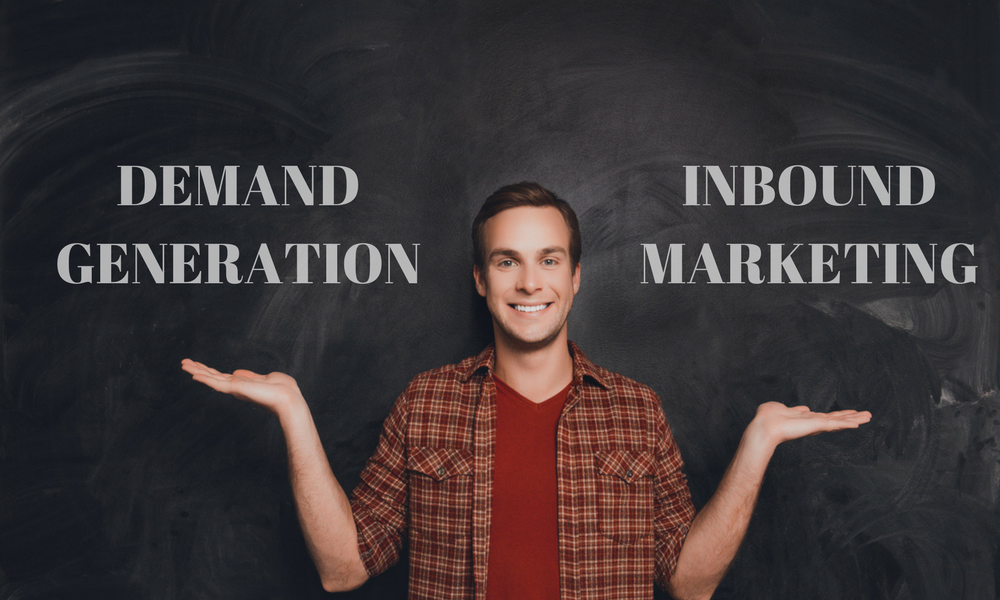Recent Studies Show That It Might Not Be One Or The Other
When it comes to our own marketing, we definitely live our core value “Practice What You Preach,” and this article is right in line.
The reason I mention this is because the blog articles in the versus collection are some of our top-performing articles. In fact, most of them end up in the top 10 of all-time viewed and clicked-on blog articles. People appear to enjoy the versus theme, and that’s why today’s article is going to be part of that collection.
Lately, I feel like demand generation (pre-awareness stage marketing) has been getting a lot of renewed attention, while inbound marketing (awareness stage marketing) has been taking more of a back seat. I’m curious as to the shift and I want to help readers understand the differences, advantages, risks and rewards, so you can make a safe, educated and results-oriented decision on marketing strategy for your company. Demand generation, inbound or both? You make the call!
Advantages, Risks And Expected Results From Demand Generation Marketing Tactics
Demand generation is defined as any activity that creates interest or awareness in your company’s products or services. By definition, it assumes awareness does not exist prior to your demand generation efforts. That’s why we consider demand generation to be pre-awareness marketing.
Advantages: It’s definitely an offensive strategy, meaning it’s proactive and attempts to find people who are not looking but are a profile prospect match nonetheless. If done well and with key tactics, like account-based marketing, it can also help align the sales and marketing teams, a goal that should be on most CEO’s wish lists. Another advantage is the acquisition of data. You can take advantage of the various data services and buy the names of potential prospects based on any number of qualification criteria. Instead of waiting for them to come to you, you go to them.
Risks: I could have called these disadvantages, but I like risks better because risks can always be mitigated with good plans and strategy. Just because there are risks doesn’t mean we don’t move forward. Typically, demand generation programs require bigger budgets and longer time frames for the investments to produce return.
In most cases, you’re renting names, so you don’t own the contact information. You’re interrupting potential prospects, so there’s a risk in spoiling some brand equity with some of the target market. Less data on the performance of the program is usually available, making it more challenging to optimize program performance and cut out non-performing aspects of the marketing effort.
Expected Results: If time is not on your side and you need leads immediately, demand generation tactics typically produce results in a shorter time frame than some deployments of inbound, but driving those results might require a bigger budget. For example, you can pump money into pay-per-click and produce results sooner than waiting for your organic search engine optimization to kick in.
When you’re talking about targeting people who are not even in the awareness stage of their buyer journey, you should expect longer sales cycles for these leads, but perhaps you end up with more leads because you’re bringing into your pipeline people who would not have found you on their own had you not targeted them and connected with them.
Advantages, Risks And Expected Results From Inbound Marketing Tactics
Inbound marketing is about being visible when prospects are looking for information related to your company’s products or services. They are already aware and you need to be found when they start looking. This means inbound is an awareness stage marketing methodology.
Advantages: One of the biggest advantages is that you’re building a system that should redefine how you market your company, one that runs over time to produce a steady stream of people who want to talk to you without you having to continue to pump money into advertising. Instead of renting attention, you’re earning attention. It does not require the same level of investment as demand generation or advertising, so it’s a more economical option and every aspect is highly quantifiable. Over time it becomes more and more efficient.
Risks: It’s very complex. Planning it, building it and optimizing it takes expertise. If you don’t have the expertise, it’s going to be hard to get inbound to produce results in the short term. It takes time because you have to strategically plan it, build out the assets and then optimize each tactic. Don’t expect a lot from it for the first six months (at a minimum). In most cases, clients see a high level of performance in the second year.
If this is your first time planning, building and growing an inbound program, you’ll probably make a few mistakes. You can mitigate this risk by getting someone with a lot of experience to help you skip those potholes and produce results more quickly.
Inbound is limited to only those people who are actively looking for what you do. You have to be OK with that fact. This means the universe of potential prospects is going to be smaller when you practice inbound than if you’re targeting and going after anyone who fits the bill regardless of interest, like demand generation does.
Expected Results: Your expectations should be more oriented around a marathon. With inbound, it’s going to take time, but the results will build. Month over month, you’ll see more visitors, higher conversion rates and more leads. The more you invest in the creation of assets and the optimization of the program, the better the results. Inbound leads cost 61% less than demand generated leads because the money is invested into people who are already looking for you, as opposed to people who are not. It might take longer, but it’s going to cost less.
I’m not trying to make a persuasive argument for one type of marketing over the other. I think that in some cases demand generation is the perfect play and in other cases inbound makes more sense. Lately we’ve been seeing a lot of successful client programs using both in very strategic and thoughtful ways. Account-based marketing is a program that uses some very personal, direct demand gen outreach at the top of the prospect pyramid and more inbound techniques as you target lower-level prospects.
I think it’s safe to say that most companies want to be found organically on Google, and by running a pay-per-click campaign, they get the visibility needed while waiting for the organic lists to percolate up to the top of the rankings. You can earn email addresses by publishing wonderful content and you can buy email addresses, too. By creating content for both, you nurture the people who already know you, and you can bring new people into your ecosystem at the same time.
For me, it comes down to budget. If you can afford to invest in everything, there is a lot to choose from. If you have to be more selective, then you need to match up your revenue goals, expected results and budget to make sure all three of those expectations are aligned. Don’t expect to drive millions of dollars in incremental revenue for $2,000 a month in marketing spend. If you want to drive a Mercedes, you have to pay for the Mercedes.
Demand generation or inbound marketing? The choice comes down to your business goals, marketing budget and level of expertise. Understand the pluses and minuses of both and make a decision that’s right for your company, your prospects, and your marketing team.










